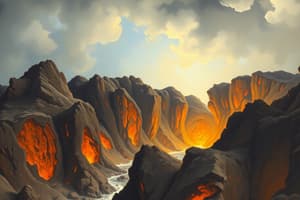Podcast
Questions and Answers
What type of lava has a smooth, billowy, undulating, or ropy surface?
What type of lava has a smooth, billowy, undulating, or ropy surface?
Pahoehoe Flow
Where are pillow lavas commonly found?
Where are pillow lavas commonly found?
Mid-Atlantic Ridge and Juan de Fuca Ridge
What is the surface expression of an impact structure called?
What is the surface expression of an impact structure called?
Impact Crater
What are planar deformation features (PDFs) in minerals within in situ lithologies?
What are planar deformation features (PDFs) in minerals within in situ lithologies?
What are shatter cones?
What are shatter cones?
What are high-pressure mineral polymorphs within in situ lithologies?
What are high-pressure mineral polymorphs within in situ lithologies?
What is a conformable contact in sedimentary rocks?
What is a conformable contact in sedimentary rocks?
Define unconformable contact in geology.
Define unconformable contact in geology.
What is an angular unconformity and how is it characterized?
What is an angular unconformity and how is it characterized?
Explain a nonconformity in geology.
Explain a nonconformity in geology.
What is a disconformity and how are the separated layers oriented?
What is a disconformity and how are the separated layers oriented?
How is a nonconformity different from an angular unconformity?
How is a nonconformity different from an angular unconformity?
What is the distinguishing characteristic of a Flute Cast?
What is the distinguishing characteristic of a Flute Cast?
What causes the formation of Crescent obstacle scours?
What causes the formation of Crescent obstacle scours?
What distinguishes Load Casts from Flute Casts?
What distinguishes Load Casts from Flute Casts?
How are Mudcracks formed and where are they commonly seen?
How are Mudcracks formed and where are they commonly seen?
What is the difference between Mudcracks and Syneresis cracks?
What is the difference between Mudcracks and Syneresis cracks?
What is the distinguishing characteristic of a Current Crescent?
What is the distinguishing characteristic of a Current Crescent?
What is the definition of Planar Attitude?
What is the definition of Planar Attitude?
How is Strike defined?
How is Strike defined?
What is True Dip?
What is True Dip?
What is Apparent Dip?
What is Apparent Dip?
How is Trend defined?
How is Trend defined?
Explain the Right-Hand Rule in the context of strike and dip.
Explain the Right-Hand Rule in the context of strike and dip.
What is the difference between a stock and a batholith based on their surface exposure?
What is the difference between a stock and a batholith based on their surface exposure?
Describe the shape of a laccolith and how it forms.
Describe the shape of a laccolith and how it forms.
What distinguishes a lopolith in terms of shape and concordance with the intruded strata?
What distinguishes a lopolith in terms of shape and concordance with the intruded strata?
Explain the specific location where a phacolith typically occurs and its shape.
Explain the specific location where a phacolith typically occurs and its shape.
What is the defining feature of an aa flow in terms of its surface characteristics and composition?
What is the defining feature of an aa flow in terms of its surface characteristics and composition?
How do lobate lava flows differ from pahoehoe flows and where are they commonly found?
How do lobate lava flows differ from pahoehoe flows and where are they commonly found?
Flashcards are hidden until you start studying




